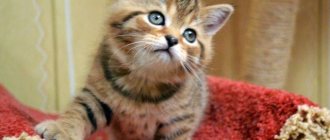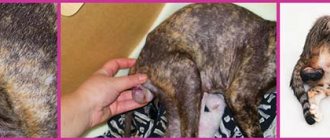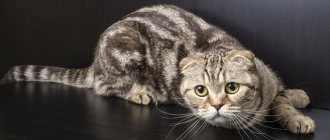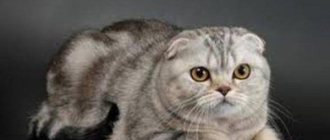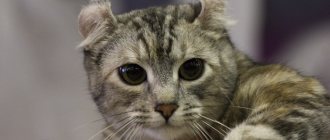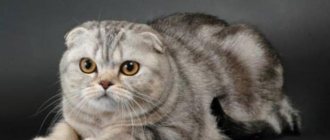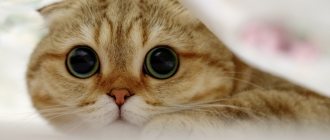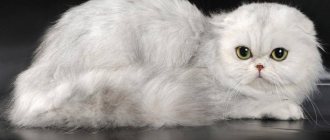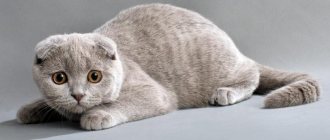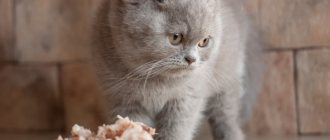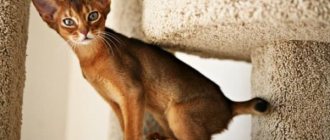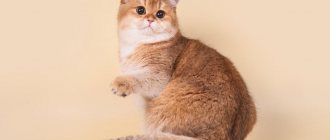The health, activity and well-being of a pet depends, first of all, on proper and balanced nutrition. The cat must receive the macro- and microelements, vitamins, proteins and other substances it needs for the proper functioning of all systems of its body.
Proper nutrition ensures resistance to infections, minimizes the risk of developing diseases and their transition to a chronic form. Thus, the issue of choosing food for Scottish cats and preparing their diet must be approached with all responsibility and seriousness.
Tips on choosing food and preparing a diet for Scots.
Nutrition rules
For an adult pet, the daily diet of natural feeding should be at least 200 grams per day.
The exact weight is calculated for each animal individually, based on its weight and age. The norm is 3-5% of the cat’s body weight, in terms of energy value this is approximately 335 kilojoules. If the cat is young and active, the norm should be 10-15 higher.
For kittens under the age of 1 year, pregnant and lactating cats, the norm should also be increased. The weight of the daily diet should be at least 10% of the animal’s body weight. For castrated and sterilized pets, the diet, on the contrary, should be reduced so as not to cause obesity and chronic diseases associated with excess weight.
The choice of nutrition depends on the tolerance of a particular product. It is easier to balance natural food, since you can use a variety of vegetables, meat, offal, dairy and others.
You should know that plant proteins are poorly absorbed by the body of predators. If they prevail, the risk of pathologies and diseases increases many times over. For a cat, the proportion of animal and vegetable protein should be 40% to 60%.
Carbohydrates should be limited for Scottish Fold and Straight-eared cats. Their share should be no more than 12%. A high proportion of carbohydrates in food can lead to the development of gastrointestinal (gastrointestinal) diseases. The pancreas of the animal is the most vulnerable and suffers first. Veterinarians and animal nutrition specialists have established the optimal proportion of proper nutrition:
- 52% protein;
- 12% carbohydrates;
- 36% fat.
Fats are also important, as they are necessary to keep your cat active. Their share should not be lower than 5%, the optimal level is 15%. First of all, it must be fat of animal origin; vegetable fat does not have any beneficial properties for the Scots body. If the animal receives such nutrition, the risk of diseases and pathologies is minimized.
Basic rules for feeding kittens
You bought a Scottish kitten, and the question arose of what to feed it. If you adhere to the principles of a natural diet, a lot will depend on the age of the pet.
You can read more in our articles:
- Feeding a kitten aged 1 month;
- Feeding a kitten at the age of 2 months;
- Feeding 3 month old kittens;
- Feeding a kitten at six months.
If you have made a choice in favor of dry food, we have compiled a rating of the “10 best foods for Scottish kittens.” The best price/quality ratio is Earthborn Holistic, Primitive Feline Natural Cat Food. Among inexpensive foods, 1st Choice Kitten will optimally satisfy the needs of a kitten. A good option would be Wahre Liebe “Junge” food.
What to feed a kitten: breakdown by month
The Scottish Fold cat requires its own care and feeding. The animal's food should differ depending on the degree of maturity. A kitten's diet is very different from that of an adult cat. This is due to differences and features in the digestive system. The required amount of dry food is presented in the table below (recommendations from different manufacturers may vary slightly). Let's take a closer look at creating a natural feeding diet.
Calculation table for dry food for Scottish kittens.
1 month
During this period, the kitten begins to receive its first complementary foods. The basis is cat milk or special ready-made formulas for feeding kittens. During this period, you need to start introducing the following products:
- boiled finely chopped chicken;
- boiled cereals with milk;
- chopped boiled vegetables - cabbage, apple, carrots;
- fermented milk products, cottage cheese with a high calcium content is especially useful.
All food should be at room temperature. After eating, there should be no pieces of food in the bowl. Anything that the kitten hasn’t eaten should be thrown away and the dishes themselves should be washed thoroughly. The diet for a month to six months should be rich and contain substances necessary for the growth and development of the kitten.
Second month
During this period, the kitten begins to actively grow and new teeth appear. Therefore, the diet must correspond to this. Food for Scottish kittens should have:
- boiled chicken or beef;
- low-fat fermented milk products;
- porridge;
- raw vegetables;
- egg yolk, which can be added to meat.
The kitten's food should not contain salt or spices, and the meat should be given in the form of small pieces so that the animal does not choke.
Selecting a diet for a kitten.
Third month
At this age, the kitten already has formed teeth. Meat can be given in the form of medium cubes. The menu itself looks like this:
- boiled beef;
- skinless chicken;
- cereals;
- yolk;
- cottage cheese;
- fermented baked milk;
- lean fish (frozen and without bones);
- meat by-products.
Chicken hearts and necks are suitable as offal. Before giving them to the animal, they must be brought to room temperature.
Fourth month
The diet includes more products:
- raw beef;
- boiled chicken;
- porridge;
- 2 yolks per week, raw or boiled;
- raw vegetables;
- fruits;
- sea fish;
- various fermented milk products.
Fish is introduced into the diet in stages, starting with small pieces, as it can cause allergic reactions in the animal. It is strictly forbidden to give raw fish, especially river fish. There are a lot of bones and a risk of parasites.
Fifth month
During this period, food consists of the following products:
- raw or boiled lean meat;
- dairy products;
- vegetables;
- cereals;
- meat broths;
- greenery.
From this period, the kitten can receive vitamin supplements, which must be prescribed by a veterinarian.
Material on the topic: what to feed British breed cats.
Six months
At this age, cats undergo a castration procedure. After this operation, nutrition must be adjusted. It should look like this:
- foods high in fiber and vitamins;
- exclude fish;
- porridge;
- offal once a week;
- more raw vegetables;
- You can give meat broths several times a week.
A Scottish kitten receiving ready-made food should only eat food that is specifically intended for castrated (sterilized) individuals. It is worth choosing holistic, premium, super-premium class for a specific breed.
Kitten 7-12 months
At this age, the kitten becomes a teenager. He should receive food 4 times a day. Some animals themselves refuse fractional meals and switch to 2-3 meals a day. A cat's diet is at least 180 grams of food.
Feeding adult cats
You need to feed your Scottish kitten thoughtfully, like any purebred pet. These breeds are more picky about their diet. An adult animal should eat:
- Lean meats. It is preferable to choose turkey and veal that has undergone heat treatment.
- Fish several times a week if the animal is not castrated. Fish contains phosphorus, which can lead to diseases of the genitourinary system, especially if it is sterilized.
- Porridge is a must in your diet. Oatmeal or rolled oats and rice are especially good.
- Vegetables, greens. They can be raw or boiled. They can be added to meat and porridge.
- To ensure that the animal receives vitamins, a vitamin-mineral complex is suitable.
Appetite is affected by the temperature in the apartment and the time of year. In winter and autumn, cats may eat more often and more; during this period, their feeling of hunger becomes more acute.
In summer or if the apartment is hot, the cat will drink more often. Every animal should have unlimited access to clean water. Very often, tap water can be hard and contain chlorine. Therefore, it is better to give bottled or filtered water.
An essential substance for cats is taurine. This is a special amino acid necessary for cardiac activity and vision. This substance is found in animal protein. Meat should play a key role in your pet's nutrition.
How to feed sterilized Scots
After such surgery, cats are prone to weight gain and the development of urolithiasis. In this case, you need to switch your pet to a different diet. Homemade food for a Scottish kitten should be adjusted towards reducing the fat content of the food. There are several basic recommendations for such animals:
- Regular food for neutered cats is not suitable. Do not mix natural diet and prepared food.
- If your cat receives raw and dry food, they must be the same brand.
- You need to feed in small portions, calculated according to age, weight, and health status. Give food four times a day.
The food must meet certain requirements: protein content of at least 50%, exclude phosphorus, potassium, calcium, magnesium. These trace elements cause the development of urolithiasis. Carbohydrates affect weight gain, their content should be reduced to 25%.
Natural food
The option is not the simplest, and also requires some costs. To create a natural menu in accordance with the requirements of the Scottish cat, you will have to come up with several healthy recipes.
Food from the table is harmful to the cat!
Let's look at what foods you should give your cat:
- Meat . It must be either frozen or heat-treated. Regular raw meat should not be given to cats. Of the varieties, preference should be given to low-fat varieties, for example, beef.
- Bird . The best option would be chicken meat. It must be boiled before use.
- By-products , such as liver. You should treat your pet with it no more than once a week. Be sure to boil before serving.
- Fish . Only marine and low-fat. The ubiquitous myth that any fish is good for cats is high time to debunk. River fish is dangerous for cats' health! Therefore, you can treat your cat to seafood no more than once a week.
- Dairy products . Offer your Scottish cat cheese, sour cream or kefir several times a week. It is unlikely that your pet will refuse such a tasty treat.
- Eggs , namely boiled chicken yolk.
- Milk and milk porridges are beneficial for young animals. They are necessary in the diet only until the age of 6 months. After this period, dairy products can cause distress in the cat.
- Cereals. Optimal source of slow carbohydrates. The cat gets energy from them, so it is necessary to treat your pet with rice, buckwheat and oatmeal. If the cat thinks otherwise, convince him otherwise by mixing porridge with meat.
- Vegetables. Source of vitamins. Most likely, boiled carrots will also have to be mixed with meat, but it’s worth it. After all, the health of your pet depends on the presence of vitamins.
Someone's hungry
Cats are carnivores by nature, so the main ingredient in a Scottish cat's diet should be meat. Protein is essential for muscle building, visual acuity and reproductive function.
Remember about product compatibility. When feeding Scottish and other breeds, it is important not to mix incompatible foods: dairy treats should be a separate meal. The same goes for vegetables.
What cats can't do
When creating a diet, it is important not only to provide your cat with healthy foods, but also to protect them from harmful ones. Cats should not be given:
- Food from the table. You cannot treat cats to food with seasonings, as well as salty, smoked and sweet foods;
- Fatty meat is prohibited not only for Scots, but also for other breeds;
- Baked goods, baked goods and sweets.
I want to, but I can’t
Vitamins
Even the highest quality natural food is not able to provide a cat’s body with the necessary vitamins. To give your pet a burst of strength, buy a vitamin and mineral complex for cats at a veterinary pharmacy.
The tablets are usually “equipped” with a pleasant smell, so giving the pill to your cat will not be difficult.
In some pharmacies you can find special complexes for the Scottish breed. The composition of such tablets takes into account the breed’s love of hunting and meat products, and also adds the required amount of plant elements.
It wouldn’t hurt to grow a pot of “cat” grass on the windowsill. Seeds of such a delicacy can be bought at the same pet store. The sprouts will hatch in just a few days, and the cat will have the opportunity to eat a fresh, vitamin-rich salad.
Personal lawn
In addition to food, the cat should have drinking water in a separate bowl. The drink needs to be changed daily. Some pets prefer to drink tap water, which does not cause any harm.
You cannot bring grass from the street for your cat! The stems of outdoor plants may contain parasite larvae that can infect your pet.
Examples of natural dishes
To avoid wondering what to cook for your Scottish cat for lunch, use one of the tips below:
- Pour boiling water over fresh beef (75 grams) and add 20 grams to it. lungs. Mix all this with oatmeal steamed in boiling water. Add half a teaspoon of vegetable oil and dry yeast (on the tip of a knife) to the finished porridge.
- Mix boiled buckwheat with chopped liver. Add lean, boneless fish. If necessary, add a small amount of water and grind the mixture using a blender.
Features of feeding pregnant cats
A pregnant cat should be fed in small portions, but more often than usual. Cheese and cottage cheese should be included in the diet with calcium. Liver, greens, and vegetables will be useful. Lactating cats eat more than pregnant cats because the body spends a lot of calories producing milk. The amount of protein food should be 30%.
How to feed a nursing Scottish cat
If the cat experiences hunger, her milk production, which is necessary for kittens, will be interrupted or disrupted.
She must receive good nutrition in sufficient quantities. You need to feed at least 3-4 times a day, but many veterinarians recommend providing unlimited access to food during this period. If there are three or more kittens in the litter, the mother cat is definitely not at risk of obesity.
In the third or fourth week, babies begin to be fed additionally with food other than mother's milk. This reduces the amount of milk consumed.
During lactation, you can give natural or commercially prepared food. Special additives must be given as feeding.
What food is recommended for Scottish cats?
Food for Scottish fold and straight-eared cats can be natural, industrial, or mixed. Food from the common table cannot be used as natural food. Products that have undergone special heat treatment must be selected for the cat. The animal's diet should be as close to natural as possible. Often, special supplements are used along with this regimen. The simplest, but also more expensive option is industrially prepared food. They contain all the necessary substances for the pet's health.
Note! Veterinarians strictly prohibit mixing natural food and ready-made cat food.
What types of ready-made food are there for the Scottish breed?
You can feed a Scottish straight-eared kitten in the same way as a fold-eared kitten - ready-made food. The main question is to choose the right one from the whole variety of brands. For purebred animals, three types of feed are chosen:
- holistic;
- premium;
- super premium.
These foods have a balanced composition and are made from high-quality ingredients. Only good meat that has undergone strict control and processing is used as raw material. Some of the best brands include:
- Acana Pacifica for Cats;
- Earthborn Holistic;
- 1st Choice Adult Cat;
- Royal Canin British Shorthair;
- Flatazor Crocktail Adulte Poissons.
These foods meet the recommendations of veterinarians - protein content 26%, fat - 9%, for pregnant and lactating women - 30%.
What to choose – natural food or industrial feed
This question does not have a clear answer either among veterinarians or among owners of Scottish cats. Both types of diet have both advantages and disadvantages.
Eating from natural products is considered natural, and therefore more healthy. But only if all products are of high quality and properly prepared, the ratio of fats, proteins and carbohydrates is observed in ready-made dishes. When buying chicken, you cannot be sure of its quality, and there is also no guarantee that it does not contain antibiotics, and the meat has not been chemically treated for better and longer preservation.
The vitamins that cats need are found in vegetables. But how many representatives of the cat world will agree to consume them, and in such quantities as to replenish the required amount of vitamins and minerals for the body?
Natural feeding may not be entirely convenient for the owners themselves. Feeding a Scottish cat from a common table is strictly prohibited, and a working person may not have enough time to prepare a variety of dishes for his pet every day.
Then production rations come to the rescue - dry and wet food. The advantage of using industrial feed is that it contains a balanced content of proteins, carbohydrates and fats. These foods also contain all the minerals necessary for a Scottish cat.
But even here there are pitfalls. To make industrial food tasty, varied and healthy, you need to give preference to holistic and super-premium products. However, they are quite expensive, and not every pet owner can afford to buy them.
If a Scottish cat is on natural feeding, or its diet consists of inexpensive, and therefore not very high-quality industrial food, it needs to be regularly given vitamins and do not forget about a preventive examination by a veterinarian.
How to feed natural food
You need to follow some recommendations when feeding your Scottish Straight kitten:
- kittens up to six months old should receive food 10 times a day;
- over 6 months – four times;
- adults - 3-3 times.
The main food ingredient is meat and meat products. It should be non-greasy. The best options are turkey, chicken, and veal. The meat is combined with porridges cooked in meat broth or water with the addition of vegetables. They can be raw or cooked.
Suitable vegetables: cabbage, carrots, beets. You should not include potatoes, they contain a lot of starch, which negatively affects the digestive system.
Interesting read: who are the lop-eared Britons?
Meat: a must and staple product
Fatty meat will lead to the development of pancreatic diseases. She may not be able to cope with it, and as a result, this is the cause of pancreatitis. Rabbit, veal, quail, and turkey are considered low-fat. Turkey and rabbit can be called ideal. You should not feed chicken often; it contains high levels of antibiotics and growth-stimulating substances. It is better to use turkey meat instead.
The meat is given raw or boiled. The first option is preferable, the main thing is that it does not contain helminths. It is recommended to freeze meat for three days. This procedure completely rids the meat of parasites.
Meat produced on an industrial scale is free of parasites. On such farms, animals are specially treated, they receive special additives and feed. The risk of parasite infection in this case is minimized.
Nutritional supplements
Many cats need additional vitamins, which they may not be getting enough from their diet. Such supplements are available for kittens, adult cats, nursing cats and others. For Scottish Fold or Straight-eared kittens, vitamins have been developed that act on bones, cartilage, and their proper formation. They contain taurine, which is vital for cats.
Vitamin supplements have different directions - for coat health, general health, proper growth of kittens, for strong immunity.
Industrial food
All industrial feeds are divided into three types: economy, premium and holistic. Economy class is considered cat fast food, they do not contain natural meat, they contain a lot of dyes, food additives and preservatives. Regular consumption of such foods (among them Whiskas, Kitiket) can provoke the development of serious diseases of the digestive system.
Preference should be given to premium or extra-premium and holistic specialists. They are not cheap, but they are absolutely natural and very useful. Industrial food recommended for representatives of the Scottish breed (on a mobile phone you can scroll the table horizontally with your finger):
| Name of food | Benefits and composition | Flaws |
| Acana Pacifica for Cats (dry) Holistics | Compound:
Contains cranberry, which has a beneficial effect on the genitourinary system and promotes normal digestion. All products are natural, there are no chemicals or antibiotics. Proteins, fats and carbohydrates are completely balanced. | High cost: 340 g cost 360 rubles or 180 UAH. |
| Primitive Feline Natural Cat Food Holistics | Components:
The composition contains over 30 microelements and vitamins. There are no flavorings or chemical components that enhance taste. The content of animal protein is within the recommended norm. | Difficulties with purchasing are not always available in pet stores. |
| 1st Choice Adult Cat Chicken Formula Super-premium | Compound:
The composition contains a fruit additive in the form of pineapple, which is enriched with a high content of vitamins and minerals. Normalizes the functioning of the digestive system and has a beneficial effect on the pancreas. The product has a high degree of saturation and is very economical in consumption. | There is cellulose - a low-quality filler that can provoke allergies. |
| Royal Canin British Shorthair Premium | Compound:
Among the components there is a high content of Omega-3 acids, which are necessary for the normal functioning of the heart muscle and circulatory system. The peculiarity of the food is its shape - it is curved, and the animal cannot swallow it whole. This food helps to thoroughly clean your cat’s teeth and mouth. | The food contains corn, which is a strong allergen. |
| Flatazor Crocktail Adult Poissons (suitable for Scots who love fish products) Premium | Compound:
The food is unique in that it contains an extract of the Yucca plant, which softens and significantly removes the smell of cat feces. The composition is enriched with essential mineral elements and vitamins. Animal fat content is 85%. | The food contains corn, which can cause an allergic reaction. |
Industrial feed for little Scots
It is strictly forbidden for kittens to be given food suitable for adults. For them, the developers of cat food produce specialized food, taking into account all the features and specifics of the growing body of a Scot (on a mobile phone, you can scroll the table horizontally with your finger):
| Name of food | Compound | What gives |
| Wahre Liebe Junge |
| Has a preventive effect to prevent urolithiasis, prevents hair from rolling and coming out. |
| Hill's Science Plan Kitten Tuna |
| Helps strengthen the immune system and prevent many diseases. |
| 1st Choice Kitten |
| A balanced diet, suitable for kittens with food allergies. |
| Royal Canin Kitten Instinctive |
| Helps strengthen the immune system; a balanced composition ensures the correct and harmonious development of the animal. |
| Royal Canin British Shorthair Kitten |
| Strengthens bone and muscle tissue, provides prophylaxis, preventing the occurrence of joint diseases. |
What products are prohibited?
There are a number of foods that are prohibited from being given to the Scottish breed:
- Sweet. Cats do not have receptors for sweets; they cannot distinguish this taste from others.
- Salty. Such products can negatively affect the kidneys and bladder.
- Onion garlic.
- Chocolate. The substances contained in this product are hazardous to animals.
- Whole milk. Adult cats cannot digest this product. You can use cottage cheese, fermented baked milk, cheese for nutrition.
- Any spices, seasonings. This can damage your cat's sense of smell and pancreas.
- Citrus fruit.
All these products are completely prohibited for Scots.
Can cats have sweets?
Cat lovers say that their pets show interest in sweets: ice cream, candies, creams. Oddly enough, cats do not perceive sweet taste; they lack the gene responsible for this function. Cats like other components of high-calorie desserts: milk, butter, vegetable fats. Without distinguishing the taste of sugar, cats cannot stop in time and overeat, so you should not give sweets to your pet. Cocoa contained in chocolate can cause poisoning, increased blood pressure, and even death.
Sweets contain a lot of simple carbohydrates that are not converted into energy. The body of a cat living in a city apartment uses little energy, so “extra” carbohydrates received along with sweets turn into fat deposits and lead to obesity. Because of sugar, pets' vision decreases, dermatitis and skin itching develop, their fur falls out and becomes dull, their teeth deteriorate, and their eyes water. The functioning of the gastrointestinal tract is disrupted. The kidneys become enlarged due to excess sugar, cannot cope with their functions, and stones form in them. The risk of diabetes is another reason why you should not treat your pet to forbidden foods.
Ready-made food or natural food
You need to choose a feeding regimen based on individual characteristics. When it comes to finances, a natural diet with good meat costs about the same as a premium food choice. The main advantage of industrially produced food is that it is ready to eat and properly balanced. No need to waste time preparing.
Mixed feeding option
Veterinarians are prohibited from mixing two different diets. This leads to an imbalance in the digestive system. Such nutrition threatens disorders, deterioration of the animal’s health and other negative consequences. The food for Scottish Fold kittens should be either natural or ready-made food.
About gluten intolerance in Scots
Gluten is the gluten found in cereals. Allergies to this substance in cats are very rare. Often people themselves switch their pets to gluten-free food due to fashion and trends popular in society.
Checking your kitten for allergies
If you suspect an allergy, you will have to take an immunoglobulin test. Such reactions may include redness, irritation, itching and other symptoms. New foods should be introduced into a kitten’s diet gradually. To begin with, there should be small pieces of new food. After some time, it is worth assessing the condition of your pet.
Food for Scottish cats can be, like for any other cats, natural and ready-made. Ready-made food, especially if it belongs to the premium segment, already has a balanced composition. Cat owners will have to create a natural diet on their own, taking into account the needs of the animal.
Nutrition for aging cats
With age, metabolism slows down, activity decreases, and the appearance of the animal changes. After six to seven years, food is given in small portions, increasing the calorie content. The older the cat, the higher the tendency to be overweight and obese.
Adult pets develop age-related diseases: thyroid disorders, fatty liver, kidney stones, inflammatory diseases of the urinary tract, teeth, loss of appetite. Digestive disorders require a more attentive attitude to the menu of your favorite pussy. Harmful products are strictly prohibited.
If your adult pet is healthy, you should not put him on a strict diet without special indications. Supplement your menu with fermented milk products to reduce the risk of constipation. Purchased food is chosen from premium, superpremium, and luxury classes, enriched with microelements and vitamins E and C. Natural nutrition is also being reviewed, and by-products are excluded.
Nutrition Basics
If you don’t know what a Scottish kitten previously ate, then it’s worth building its nutrition system through experiments, but it should be one of three types.
shutterstock
Natural
The so-called natural feeding, the composition of which includes natural food prepared specifically for the animal or selected from what the owners eat. This nutrition system is the most correct and balanced if you cook for a kitten at home. Feeding a Scottish Fold cat at home according to this scheme will ensure that it has all the necessary nutrients and will contribute to the proper functioning of the digestive tract.
Feed
If you want to play it safe with natural foods, dry or wet food is a great choice. However, fold-eared cats, due to the peculiarities of their physiology, require special food that is designed specifically for this breed.
But if it is not possible to buy such expensive food, you can stop at cheaper analogues, but in any case, food for a Scots kitten must be chosen according to its age so that it can chew it and the food is properly absorbed. The composition of food for kittens and adult cats is also different; this must be taken into account when choosing the brand and type of dry or wet food;
Mixed
The third type of nutrition is quite controversial and still causes controversy among breeders. It lies in the fact that the nutrition of a Scottish Fold kitten is based on a combination of natural food and feed.
shutterstock
On the one hand, this scheme is quite good, since it ensures that the body receives all the necessary substances and natural food, and given that the food will be the most delicious for a Scottish kitten, sometimes such food will not allow you to go astray due to a change in food or improperly prepared natural food. But if the diet is structured correctly, then this option will be an ideal choice for those who cannot be at home all the time and do not have time to prepare natural products for their pet.
For lovers of factory-made food, a large number of cereals and mousses for kittens are produced, which will help become the main component of their diet, and will also teach the baby to eat various cereals, meat, and fish products.
What is forbidden to feed?
Whatever the fate of the baby - breastfeeding or with his mother, there are certain prohibitions on the use of certain categories of products in his daily menu. Since the formation of all organs in the body and the immune system continues for almost a year. This fact dictates that you carefully weigh what to feed your Scottish cat.
This list of prohibited foods includes:
- Bones. Chicken or fish - easily crushed. An animal can swallow a fragment and damage internal organs.
- Budget food. Don't forget that you are laying the foundation for health. In order for your pet to please you for many years, you need to take care of the professional quality of food and you need to be prepared for the fact that it is quite expensive. Savings on the health of a purebred fold-eared kitten will result in significant costs for its treatment in the future.
- Fish. Especially the river one. Fatty and raw foods are strictly prohibited.
- Fat meat. Proteins must predominate in the balance of nutrients. Therefore, fatty poultry, lamb or pork are excluded from feeding.
- Raw eggs - there is a risk of developing salmonella.
- Cow's milk. May cause stomach upset if given alone.
- Medicines for people. It is unlikely that you will be able to measure the required dose, and the active components of the drugs are designed for people, not animals. Taking them can be dangerous for your pet.
- Food from the human table. Sweets, spices, baked goods that have undergone special processing are prohibited: canned, fried, smoked products. The animal is forbidden to even give food for children: vegetables, spices, and sugar are also added to it, which its body does not accept.
It is mandatory for animals to include grains, vegetables and fruits in their natural diet. There are certain exceptions among them:
- legumes May cause digestive problems. In a kitten, undercooked peas or beans in the intestines will provoke fermentation processes;
- rhubarb, tomato, potato. They are not absorbed by the body and can cause problems in the gastrointestinal tract;
- garlic and onion. The substances that are in the composition begin to destroy red blood cells. Promote the appearance of anemia in large quantities;
- citrus. The animal is unlikely to eat them, but if this happens, allergies and indigestion are possible.
When the owner loves mushrooms, this does not mean that the animal can eat them: the body may not be able to cope with this source of protein; cats do not produce enzymes to digest them.
Natural menu or purchased food
Cat lovers often argue about what is better for a cat: homemade food or commercial food. There is no clear opinion; everyone gives their pet the food they consider appropriate. They agree on one thing: it is better to feed one thing - either homemade products or food. Proponents of home nutrition believe that products from the owner’s table are quite suitable for a pet if the diet is balanced, and artificial additives contained in food can harm the cat’s health, so they choose a natural product. As an example, they cite street animals that consume only “natural products” and at the same time live to an old age without any special health problems. In addition, they remember the ancestors of domestic cats, who ate only what they could catch.
Those who choose industrial food believe that experts create a diet taking into account the needs of cats of different ages based on many years of research, so ready-made food is more balanced than homemade food. Industrial food includes vitamins and microelements that a cat is guaranteed to eat, but not every owner can persuade a pet to eat carrots. In addition, it does not need to be prepared or calculated proportions, dry food has a long shelf life, does not stain dishes, and is easy to clean up after your pet. Animals, unlike people, cannot appreciate the taste and variety of their diet; it is important for them that the food contains all the necessary substances.
Both sides have reasonable arguments, and only you can decide which diet to choose: food or natural food. It is better to consult a veterinarian, he will tell you what food is best to feed your Scottish Fold cat.
Menu for a neutered cat
The menu of a sterilized animal will require changes. The main problem of castrated and neutered Scots is urolithiasis. Males suffer more from kidney stones due to the structural features of the body. The narrow urinary canal does not allow the stone to pass out on its own, and the situation is aggravated by obstruction of the urethra due to inflammation.
It is important to know that neutered cats are at risk!
Accustom your cat to a diet menu. The main prohibition is to eat foods high in magnesium, phosphorus and calcium, because they lead to the formation of stones. When choosing commercial food, pay attention to a specialized diet for sterilized animals, approved by veterinarians. They contain special substances that can acidify urine, preventing the formation of stones.
Be sure to make sure your pet is drinking enough fluids. Natural food contains enough moisture, so it partially fills this need. Dry food contains virtually no moisture, so make sure your cat drinks three times more water than he eats, or soak pieces of food with water. If your cat does not like this food, switch him to wet food or natural products. And be sure to always have clean water in the bowl.
When eating natural foods, adhere to the usual principles of food selection. The basis of the diet is meat, cereals, vegetables. Due to changes in hormonal levels and a sedentary lifestyle, there is a high risk of developing obesity and diabetes. Watch how much your cat eats and do not feed him too much. It is beneficial to fast once a week.
Sterilization affects the condition of the entire body, including the health of teeth and gums. Industrial feeds contain substances aimed at preventing these problems. With a natural menu, it is useful to give meat not pureed, but in pieces, and special treats for dental health. Don't forget to keep your pet active, spend time with him, play with him.
Selecting the power type
As a rule, breeders or nurseries give Scottish Fold kittens or their straight-eared cousins to a new family at about 3 months of age.
New pets are fully socialized, have good manners and already have their own eating habits
It is only important to ask about them. Relocating to a new place of residence will cause stress and it will be better if you continue to feed Scottish kittens
You need to change your usual diet to a new one gradually, and choose it wisely.
Natural
Of course, natural feeding has its advantages:
- 100% confidence in the quality of cat food.
- Diet variety.
However, it is quite difficult to feed a Scottish Fold or Straight-eared cat with a diet prepared by yourself:
- It will take a lot of time to cook.
- A couple of times every 6-12 months, with natural feeding, a Scottish kitten needs a course of vitamins and minerals.
Natural nutrition presupposes that the Scottish kitten's menu includes:
- lean meat. The most commonly used is beef or chicken. Alternatively, rabbit or turkey is possible. Raw meat can only be served frozen to reduce the risk of helminthic infestation. By 6 months, be sure to feed your Scottish kitten offal: necks, hearts and navels, to prevent tartar. Liver only in boiled form, once a week;
- vegetables, fruits, herbs. Kittens are unlikely to eat them of their own free will. It is recommended to grate or cut into cubes and then add to chopped meat or cook in broth. Make sure you always have sprouted grass;
- low-carb cereals. Only as a supplement to nutrition. They cannot be used as a basis;
- milk. Only up to 3 months: in the form of porridge, always boiled;
- fermented milk food. There should not be a lot - excess calcium can cause Scottish Folds to straighten their ears. Unlike kittens of other breeds, they are recommended to be given fermented milk products about once a week;
- vegetable oil. A small amount to season vegetables or add to porridge;
- boiled eggs - one yolk per week;
- sea fish. For variety and to provide the body with fatty acids, you can give it once a week. Low-fat and only boiled.
It is necessary to carefully check portions and feed only fresh food each time. Do not leave it in the bowl. Take care of the water, it should be in the public domain.
Industrial feed
If you don’t have time to look for delicacies and prepare the next meal from them for the Scottish aristocrat, take a closer look at ready-made food.
They come in dry and wet varieties, designed specifically for kittens. The packaging should detail the composition and consumption rates per kilogram of weight, as well as the frequency of feeding.
Wet food eliminates the problem of saturating the Scottish kitten's body with moisture, because some practically do not drink. However, this is a more expensive food option. Food should not be left in a bowl; a fresh portion is needed every time.
Wet food is recommended to feed Scottish kittens when transitioning from breastfeeding to regular feeding. Then owners most often switch them to dry food. Every change should be smooth and gradual.
It is important that the food is of professional quality, original production. Don't buy economy options
There is nothing in them except ballast substances and raw materials of dubious origin.
High-quality dry food has undoubted advantages:
- guarantees the Scottish kitten a balance of vitamins, minerals, nutrients and amino acids. No need for additives;
- prevention of tartar;
- ease of use for the owner: the food is stored for a long time, is economical, and it is easy to measure the daily requirement.
Mixed feeding
Some owners combine ready-made food and natural products. If you look from the point of view of diversity, this is justified.
Further difficulties are possible - it is difficult to establish the daily intake rate. Too much caloric content leads to obesity, and too little - dystrophy. Therefore, the Scotsman’s condition must be carefully monitored: the kitten must be active, mobile and cheerful. Everything else is a sign of imbalance.
When eating a mixed diet, it is important to follow the rules:
- You cannot feed your Scottish kitten ready-made food and a portion of natural food at the same time. This is due to differences in the digestion process of feed that has undergone completely different processing.
- When combining foods of different origins, the Scottish kitten will need additional vitamin supplementation. The norms must be agreed with the veterinarian.
